TripleHead2Go: The Latest External Multi-Display Upgrade from Matrox
by Josh Venning on July 31, 2006 12:05 AM EST- Posted in
- GPUs
Installation and Configuration
The Matrox TripleHead2Go can still be classified as an "External Multi-Display Upgrade for Laptop and PC" (as the DualHead2Go was), but the tag line underneath the logo on its box refers to "Surround Graphics," something that a three monitor display hints at more than actually achieves.


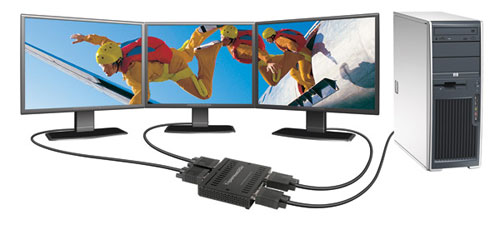
The TripleHead2Go can stretch an image across three displays, and also let you use your laptop screen as a fourth display. This provides even more flexibility for presentations or desktop applications for laptop users. The maximum resolution that can be achieved with the TripleHead2Go is 3840x1024, and it should be noted that as of right now, ATI GPUs don't support this resolution. Also, CrossFire does not support the TripleHead2Go, but NVIDIA SLI does, which is a definite drawback for ATI users. ATI has stated that this is a driver issue and not a hardware issue. They still haven't decided on whether or not to add support for the TH2G at this point. You can find a breakdown of the resolutions available on different equipment and other compatibility information about the TripleHead2Go here.
Something to note is that the TripleHead2Go offers a higher maximum resolution than the DualHead2Go, which makes sense given the extra display it supports. The TripleHead2Go can still be run as a dual head however, and if so will only support a resolution up to 2560x1024; which is also the max for the DualHead2Go.
This is the menu we see when we run the installation CD.
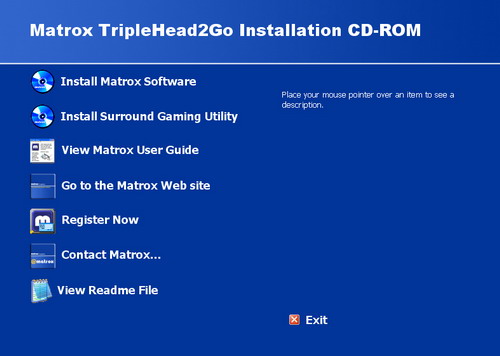
The Surround Gaming Utility is a handy program which will optimize any supported games installed on your system for widescreen surround resolutions. You can then choose to create a separate shortcut on your desktop which will run a specific game with the widescreen resolution of your choice.
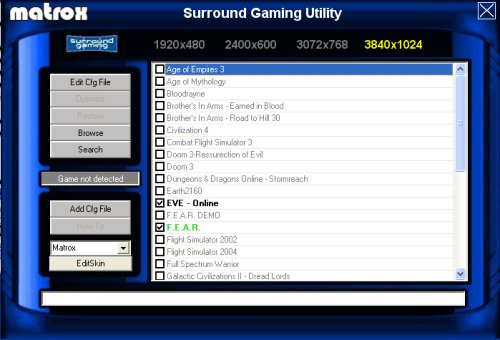
The driver interface for the TripleHead2Go is basically identical to the DualHead2Go's, and is just as easy to navigate.
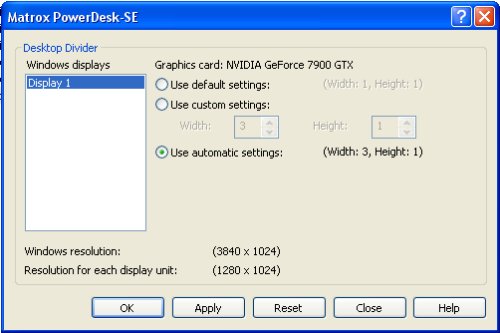
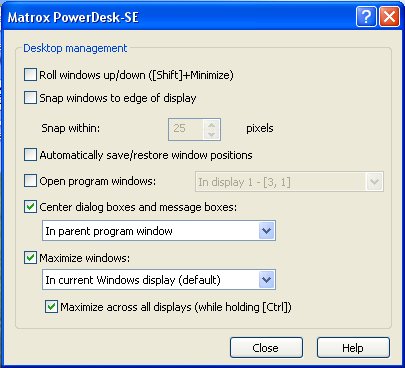
Once the device is hooked up and your system powered on, the drivers will automatically detect your setup and configure it for a widescreen display. You can also choose to duplicate displays instead of combining them for presentations and such.
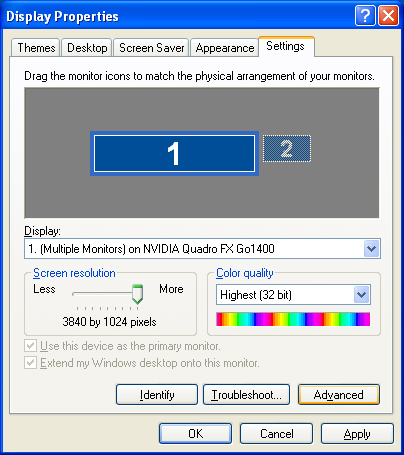
The Matrox TripleHead2Go can still be classified as an "External Multi-Display Upgrade for Laptop and PC" (as the DualHead2Go was), but the tag line underneath the logo on its box refers to "Surround Graphics," something that a three monitor display hints at more than actually achieves.



The TripleHead2Go can stretch an image across three displays, and also let you use your laptop screen as a fourth display. This provides even more flexibility for presentations or desktop applications for laptop users. The maximum resolution that can be achieved with the TripleHead2Go is 3840x1024, and it should be noted that as of right now, ATI GPUs don't support this resolution. Also, CrossFire does not support the TripleHead2Go, but NVIDIA SLI does, which is a definite drawback for ATI users. ATI has stated that this is a driver issue and not a hardware issue. They still haven't decided on whether or not to add support for the TH2G at this point. You can find a breakdown of the resolutions available on different equipment and other compatibility information about the TripleHead2Go here.
Something to note is that the TripleHead2Go offers a higher maximum resolution than the DualHead2Go, which makes sense given the extra display it supports. The TripleHead2Go can still be run as a dual head however, and if so will only support a resolution up to 2560x1024; which is also the max for the DualHead2Go.
This is the menu we see when we run the installation CD.

The Surround Gaming Utility is a handy program which will optimize any supported games installed on your system for widescreen surround resolutions. You can then choose to create a separate shortcut on your desktop which will run a specific game with the widescreen resolution of your choice.

The driver interface for the TripleHead2Go is basically identical to the DualHead2Go's, and is just as easy to navigate.


Once the device is hooked up and your system powered on, the drivers will automatically detect your setup and configure it for a widescreen display. You can also choose to duplicate displays instead of combining them for presentations and such.











23 Comments
View All Comments
blinkin2000 - Wednesday, August 2, 2006 - link
All you need is better nvidia drivers, SLI drivers that support multiple monitors. Currently they do not. I have one 7900gtx and i can span a lot of games across my two 20" lcds @3200x1200. but if SLI supported multiple monitors i would buy a third monitor and the display would be 4800x1200. Then Quad-SLI would be something to think about.If nvidia would make better SLI drivers then matrox's "niche" would disappear.
R3MF - Tuesday, August 1, 2006 - link
3072x1280 on a digital pickup would rock.araczynski - Monday, July 31, 2006 - link
nice, but until projectors come down in price and i can afford to have 3, i'll take mysxga projector over 3 19" monitors anyday.
i'm using a 24"widescreen, 19" widescreen, and 18" regular monitors on my computer at work, and i must say its very nice programming on that kind of a setup, so this device has a lot of potential aside from gaming, especially since programming doesn't exactly take serious graphics power ;).
Avalon - Monday, July 31, 2006 - link
Interesting product. It wouldn't be that bad to feasibly set up such a system, since ideally you're going to want three 19" LCDs, which can be had for under $200 a pop. The price after adding in the TH2G will probably come in close to some who buy a 2407FPW.The only thing that does stink is that half inch of space between the monitors. It does sound like a tempting DIY experiment to try and remedy that gap.
JNo - Monday, July 31, 2006 - link
but a step in the right direction admittedly...Paladin165 - Monday, July 31, 2006 - link
What I can't figure out is why some LCD manufacturer hasn't come out with LCD moniters that have the ability to sort of "snap" together, creating a more-or-less unified display. Do they really need the half-inch of plastic around the edges? Could this maybe be a DIY project to cut off the edges of these displays and get the viewable portions closer together?ksherman - Tuesday, August 1, 2006 - link
ive akways wondered the same thing... I remember the guy that made a grid of displays (cant remember how many, i think it was 5x5 or something) and it looked dumb with the lines inbetween each monitorJNo - Monday, July 31, 2006 - link
1) works best with nvidia2) no dvi
3) works with sli/crossfire? prob difficult to implement
4) limited resolutions (should support X x 1200 resolutions ideally)
5) few games supported
6) need to be able to hack FOV in other games - could be a pain
7) need 3 similar brand/model monitors ideally (for clean side-by-side setups)
8) again resolution - they were talking of being able to have a widescreen monitor in the middle and 2x 4x3 monitors at the side - that would be awesome but still not implemented
9) power - no cards/setup powerful enough to get good framerates at these huge resolutions
10) expensive
Googer - Monday, July 31, 2006 - link
I am wondering what the benchmarks would be like if the Triple Head to Go was used with a x1900xt or in SLi/Crossfire Modes?Lonyo - Monday, July 31, 2006 - link
"and while the wide resolutions were nice, the split down the middle from the sides of the two monitors pressed together made it all but useless for most types of gaming."With DualHead2Go, can you not hook up one graphics card output to it (and therefore 2 monitors) and then use the other output for a third monitor, creating a triple head setup using both the graphics cards outputs (one being double by the dualhead2go)?